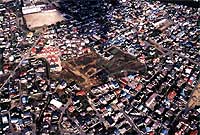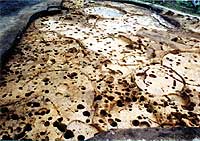
| Pseudonym reading | |
|---|---|
| Specified type | Prefecture designation |
| Type | Historic site |
| Designated date | November 24, 2000 |
| Specified details | |
| quantity | |
| location | Morioka City Odate Town |
| owner | Outside Morioka City |
| Holding group | |
| Management organization | |
| home page |
Overview
According to previous surveys, it has been found that the Odate Town site has been used for a long time from the beginning of the Jomon period (about 10,000 years ago) to the Heian period.
In particular, the largest expansion of the site is in the middle to late Jomon period (about 5,000 to 4,500 years ago), about 500 m of pit dwellings and about 1,000 earth pits in the range of about 250 m north to south and 200 m east to west.・ The grave is being built.
During this time, several large-scale settlement sites appeared in Iwate Prefecture, but the main site is one of the largest in scale and is characterized by being continuously operated.
As for the remains, many residence traces are distributed in a ring or horseshoe shape with a focus on the central plaza (tomb area), which is common to the basic design plan of Jomon-based settlements in East Japan. There is.
In addition, it is a valuable remains when examining Jomon settlements and their social structures, such as that certain restrictions can be seen when rebuilding a residence, and it is a configuration that has storage holes and the like in dwelling concentration areas. .
In addition, the pottery excavated is produced under a very solid design, and the variety of the same vessel type is diverse and superior in quantity compared to other sites, etc. It can also be pointed out that it may have been an important source of pottery production.
In addition, the existence of the cylindrical earthenware and the earthenware that influenced it reminds us that this remains is a large-scale settlement in the northern and southern part of the cultural contact area.
The above-mentioned remains and relics are well preserved over a wide range, and are important for Jomon period research in the Kitakami River basin.
(Part 1 of the 5th historic site scenic spot natural monument designation standard historic site)
image

